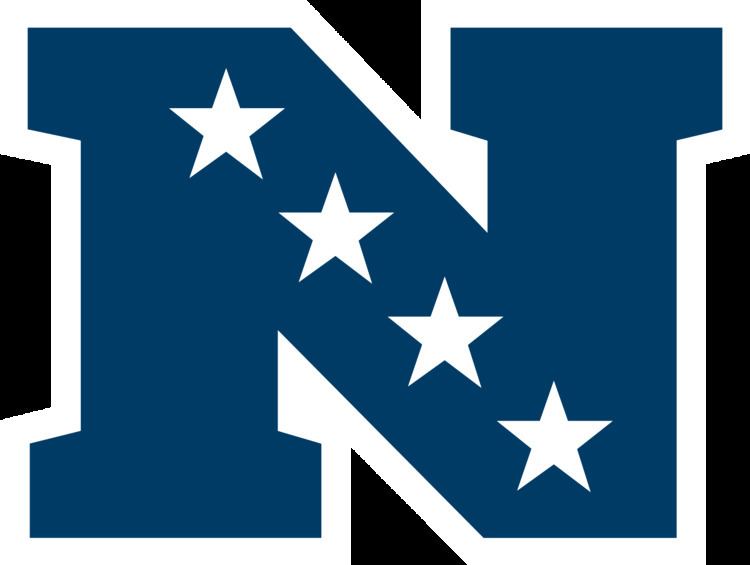Sport American football No. of teams 16 | Founded 1970 | |
 | ||
League National Football League Formerly National Football League (NFL), pre 1970 AFL–NFL merger Most recent National Football Conference champion(s) Atlanta Falcons(2nd title) | ||
The National Football Conference (NFC) is one of the two conferences of the National Football League (NFL), the highest professional level of American football in the United States. This conference and its counterpart, the American Football Conference (AFC), currently contain 16 teams each, making up the 32 teams of the NFL. Both conferences were created as part of the 1970 merger with the rival American Football League (AFL), with all ten of the former AFL teams and three NFL teams forming the AFC while the remaining thirteen NFL clubs formed the NFC. A series of league expansions and division realignments have occurred since the merger, thus making the current total 16 clubs per each conference.
Contents
Since the 1970 AFL–NFL merger, the Dallas Cowboys lead the NFC with the most conference titles (8). The current NFC title holders are the Atlanta Falcons.
Current teams
Since 2002, the NFC has 16 teams that organized into four divisions each with four teams: East, North, South, and West.
Season structure
Currently, the thirteen opponents each team faces over the 16-game regular season schedule are set using a pre-determined formula: Each NFC team plays the other teams in their respective division twice (home and away) during the regular season, in addition to 10 other games assigned to their schedule by the NFL. Two of these games are assigned on the basis of a particular team's final divisional standing from the previous season. The remaining 8 games are split between the roster of two other NFL divisions. This assignment shifts each year and will follow a standard cycle. Using the 2012 regular season schedule as an example, each team in the NFC West plays against every team in the AFC East and NFC North. In this way, non-divisional competition will be mostly among common opponents – the exception being the two games assigned based on the team's prior-season divisional standing.
At the end of each season, the top six teams in the conference proceeds into the playoff. These teams consist of the four division winners and the top two wild card teams. The NFC playoffs culminate in the NFC Championship Game with the winner receiving the George Halas Trophy. The NFC Champion then plays the AFC Champion in the Super Bowl.
History
Both the AFC and NFC were created after the NFL merged with the American Football League (AFL) in 1970. When the AFL began play in 1960 with eight teams, the NFL consisted of 13 clubs. By 1969, the AFL had expanded to ten teams and NFL to 16 clubs. In order to balance the merged league, all ten of the former AFL teams along with the NFL's Cleveland Browns, Pittsburgh Steelers, and Baltimore Colts formed the AFC, while the remaining 13 NFL teams formed the NFC.
However, team owners could not agree to a plan on how to align the clubs in the NFC. The alignment proposals were narrowed down to five finalists, and then the plan that was eventually selected was picked out of a glass bowl by then-NFL commissioner Pete Rozelle's secretary, on January 16, 1970.
The five alignment plans for the NFC in 1970 were as follows, with Plan 3 eventually selected:
Three expansion teams have joined the NFC since the merger, thus making the current total 16. When the Seattle Seahawks and the Tampa Bay Buccaneers joined the league in 1976, they were temporarily placed in the NFC and AFC, respectively, for one season before they switched conferences. The Seahawks returned to the NFC as a result of the 2002 realignment. The Carolina Panthers joined the NFC in 1995.
Parity is generally greater among NFC teams than AFC teams. The only NFC team that has never made a Super Bowl appearance is the Detroit Lions. Since the 2002 realignment, the only time that an NFC team made back-to-back Super Bowl appearances was the Seattle Seahawks in 2013 and 2014. And between 2000 and 2016, the NFC has sent 12 different teams to the Super Bowl, whereas the AFC had sent only six: the Baltimore Ravens (2 times), the Denver Broncos (2 times), the Indianapolis Colts (2 times), the Oakland Raiders (1 time), the New England Patriots (7 times), and the Pittsburgh Steelers (3 times).
Since 1970, only two teams have relocated. In 1988, the St. Louis Cardinals moved to Phoenix, Arizona, while the Los Angeles Rams moved to St. Louis in 1995, and back to Los Angeles again in 2016.
Logo
The original NFC logo, in use from 1970–2009, depicted a blue 'N' with three stars across it. The three stars represented the three divisions that were used from 1970–2001 (Eastern, Central and Western). The 2010 NFL season brought an updated NFC logo. Largely similar to the old logo, the new logo has a fourth star, representing the four divisions that have composed the NFC since 2002.
